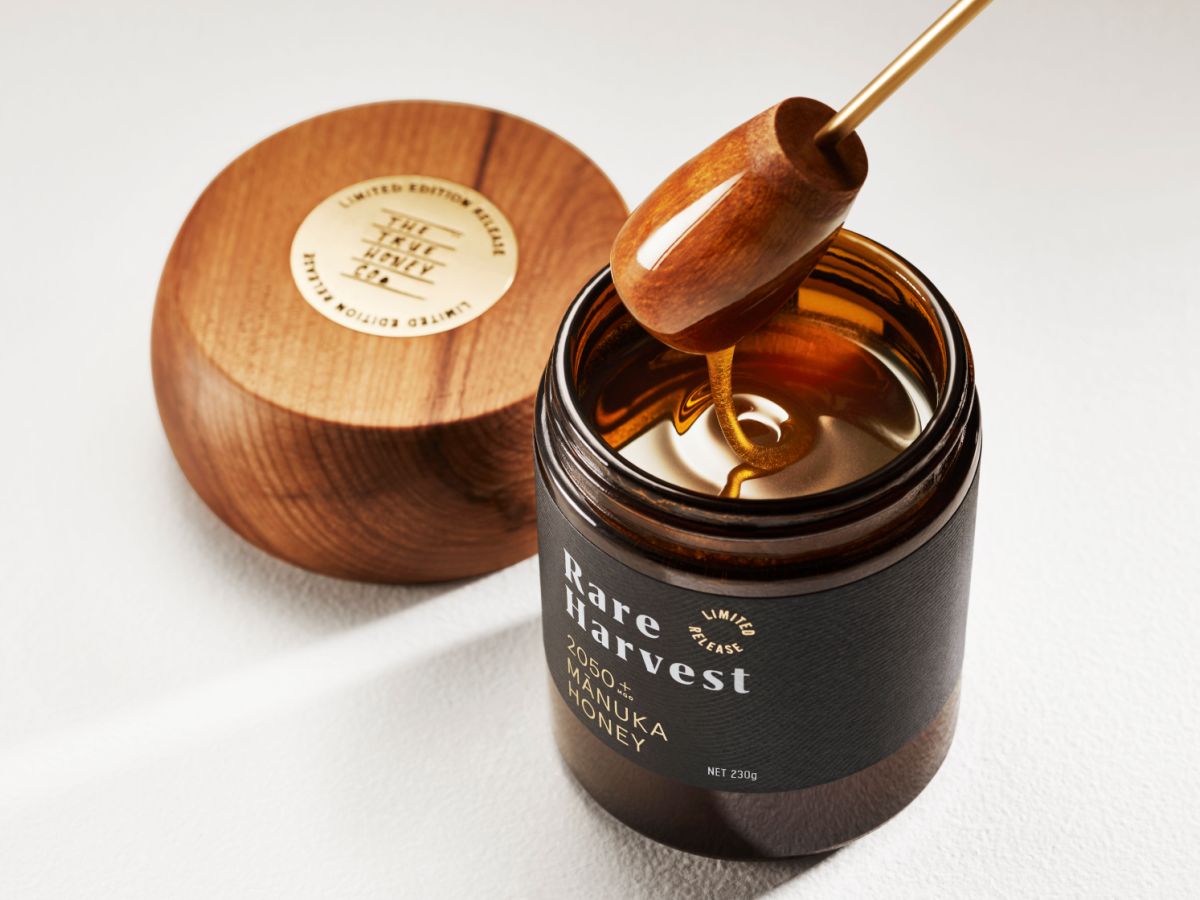The True Honey Co. has toppled its own record, harvesting a mānuka honey that has achieved the highest grade ever documented.
The Rare Harvest 2050 MGO (34 UMF™), available now, was tested for its potency by independent verifiers, the UMF™ Honey Association, who were able to confirm its position as the highest UMF™ mānuka honey in world history.
Each jar of The True Honey Co.’s Rare Harvest 2050 MGO (RRP $2500) comes with its own drizzler and is encased in a special hand crafted mānuka blossom box. It’s part of a wide range of delicious honey products available to purchase at https://truehoney.co.nz/
The True Honey Co.’s Chief Marketing Officer, Jane Willersdorf, believes those who secure a jar will fall in love with the honey, its luxurious taste and texture, and enjoy its wellness properties. “It’s exciting to share our latest achievement with some of the world’s most discerning consumers – those who recognise the beautiful, pure mānuka honey we produce as the very best in the world.”
Campbell Naish, Acting CEO at the association, says although exciting, seeing the Rare Harvest achieve 34 UMF™ came as little surprise. “We conduct up to 3,000 batch tests each year, across more than 200 brands,” says Campbell. “We also test non-UMF honey in New Zealand as well as offshore, to benchmark the performance of our members.
“We know that The True Honey Co. is committed to achieving the highest rating they possibly can, have a track record of producing high rating honey and have tailored their processes to do so. Like any high performing organisation, they are always looking to push the boundaries.” MGO, UMF – what does it all mean? MGO refers to methylglyoxal, a sugar molecule with special health properties, found in most table honey in very small quantities. In The True Honey Co.’s exceptionally pure, luxury honeys, the MGO can be over a hundred times higher. Honey claiming to have high UMF™, or Unique Mānuka Factor (which is a measurement that considers the MGO, along with other properties of the honey) is tested by the UMF™ Honey Association and given a rating, helping to ensure that New Zealand is maintaining mānuka honey quality for consumers around the globe.

Jim McMillan (Te Atiawa), the founder and CEO of The True Honey Co., says a jar of his most precious mānuka honey is delicious, particularly consumed straight off a spoon. And its health benefits are unparalleled. “It certainly has a strong flavour” Jim says. “It’s similar to toffee – both sweet and savoury, with a slight mocha note. I absolutely love it. But there’s also the experience of feeling its natural goodness running through your body. Our customers tell us they buy our Rare Harvest wanting to invest in the best of the best for optimal health and wellbeing.”
With only 1000 highly coveted beautiful amber glass jars available, each sealed with a luxurious hand-turned native timber lid, demand for the Rare Harvest 2050 MGO has already exceeded expectation. Half of this extremely limited-edition honey was sold to eager customers – excited by the prospect of a high performing honey that is widely known to boost immunity, relieve symptoms of cold and flu and promote gut health – weeks before it launched.
That clientele includes affluent Middle Eastern families (one bought 60 jars) and prestige retailers Harrods and Selfridges in the United Kingdom (The True Honey Co. previously collaborated with Harrods to launch the 1900 MGO, which was the highest grade available until this release.) In Germany, the honey has been purchased by a premium food distributor, and back home, by businesses looking to gift something authentically representative of Aotearoa to visiting colleagues.
“I feel really proud of our team for their enthusiasm and commitment when it comes to the production of ultra-high grade mānuka honey,” says Jim. “To make mānuka honey of this grade takes an exceptional set of environmental circumstances along with the utmost care and attention to the hives and honey maturation process.”
In order to achieve a world record honey, Jim and his team partner with landowners who have large stands of pristine mānuka on their properties. Most are incredibly remote, so Jim deploys helicopters to drop the hives into their top-secret locations, where they stay for the duration of the mānuka flowering season before being lifted out.
It’s been done that way for 10 years, since the first time Jim spied a block of mānuka from the sky and thought ‘We should produce honey there!’
“It’s a precision operation,” Jim tells. “Using helicopters means we can place our hives in the middle of remote dense stands of mānuka – places roads don’t reach – ensuring only the absolute purest mānuka nectar is sourced.”



